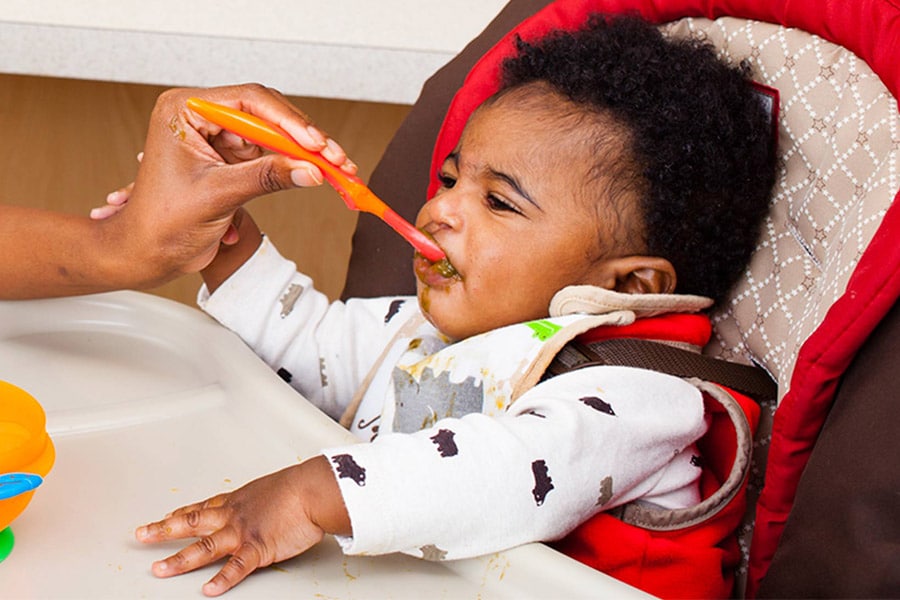Introducing Solid Foods to Baby

At around 6 months of age your baby may start to show signs they are ready for solid foods. If they can sit with support, have good head and neck control, and are showing interest in food it may be the right time for starting solids.
Baby’s first foods can be an adventure! There may be lots of spitting out, funny faces and multiple tries before a baby accepts new tastes and textures. Just know all of that is normal, and try to be positive and patient as your baby explores the fun new world of solid foods.
Part of this new adventure also includes introducing potential allergens to baby. You won’t know how your child will react to some foods, and that’s OK. Just look out for signs of food allergies. If you notice a rash, hives, dry skin or tummy trouble, talk with your baby’s doctor. If your baby is having trouble breathing, they need immediate medical attention.
Ready to start your baby’s adventure with solid foods? Read on for more tips!
In this article:
Which foods should I introduce to my baby first?
For all infants, it’s important to start with iron- and zinc-rich foods. Iron is an important mineral that helps carry oxygen throughout your baby’s body and brain, and zinc aids digestion and helps build a heathy immune system.
Foods that are rich in iron and zinc include:
- Fortified infant cereal
- Pureed chickpeas, lentils, beans and peas
- Pureed meat, poultry and fish
Don’t worry if baby doesn’t eat much at first. These are all new tastes, textures and smells, so it’s normal for them to take it slow or even refuse at first. Keep in mind that breastmilk or infant formula will continue to provide most of your child’s nutrition during the first year of life.
Which vegetables should I try when starting solids for baby?
After your baby gets the hang of eating iron- and zinc-rich foods for a few days, you can move on to trying veggies. When introducing new foods wait 3 to 5 days between each new food to determine whether your child has any reactions to the food offered.
Great first veggies to try:
- Pureed carrots
- Pureed squash
- Pureed broccoli
- Pureed sweet potatoes
- Pureed green beans

Which fruits should I try when starting solids for baby?
After introducing veggies, let baby try 1 single-ingredient fruit at a time. There are plenty of fruits to choose from:
- Pureed apples
- Pureed bananas
- Pureed pears
- Pureed prunes
- Pureed avocado
- Pureed peaches
Once baby has tried a variety of single-ingredient foods, the real fun can begin! You can combine flavors, like peas and carrots, beans and sweet potatoes, or cereal and bananas. Just be sure you don’t mix fruit into everything so they learn to enjoy the taste of foods that aren’t always sweet.
Is introducing allergens to baby safe when starting solids?
Introducing baby to their first foods is an exciting time. Research shows it is also the time to introduce allergen foods because early introduction may help lower your baby’s risk of developing food allergies.
If you have a family history of food allergies, speak with your baby’s doctor before offering. Some top allergen foods to introduce at this time:
- Nut butter: a pea-sized amount mixed into infant cereal or thinned out with breastmilk or infant formula. Exposing baby to a variety of nuts is important—peanut butter, almond butter, cashew butter, etc.
- Dairy products: plain yogurt or cottage cheese
- Eggs
- Fish
- Wheat, such as Cream of Wheat
- Soybeans, such as pureed or mashed tofu and edamame
What to avoid when introducing baby to solid foods
Your baby’s taste buds are brand new, so plain meats, beans, veggies and fruits have the perfect amount of flavor. Your baby does not need sugar or salt added to their food to make it more flavorful.
In fact, added sugar is not recommended until your child is 2 years or older, and too much salt can hurt your baby’s kidneys. Honey is especially dangerous, as it can contain a bacteria that can cause botulism in babies. Botulism can lead to serious complications, such as muscle weakness, breathing problems, extreme tiredness and a weak cry. Adding these ingredients teaches their young taste buds to prefer the flavor of sugar and salt instead of the natural flavor of the food.
Read labels to make sure your baby foods don’t include these added ingredients, and be sure not to add them at home.
-
Make your own baby food in less than 20 minutes
Making your own baby food is easier than you think. Watch this video to get step-by-step instructions on how to make your own healthy, budget-friendly baby food in less than 20 minutes.

